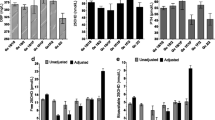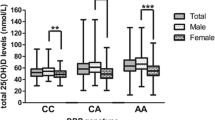Abstract
The major transporter of vitamin D metabolites in the circulation is the multifunctional plasma protein Gc, also known as group-specific component, Gc globulin, vitamin D–binding protein, or DBP. There are several phenotypes of Gc, and we examined the influence of Gc phenotype and Gc concentration on vitamin D status. By using isoelectric focusing we identified the Gc phenotype of 595 caucasian recent postmenopausal women enrolled into the Danish Osteoporosis Prevention Study (DOPS). We measured plasma concentration of Gc by immunonephelometry (coefficient of variation [CV] < 5%), 25-hydroxy vitamin D (25OHD) by a competitive protein-binding assay (CV 10%), and 1,25-dihydroxy-vitamin D (1,25(OH)2D) by a radioimmunoassay (CV 6–14%), and calculated index as the molar ratio of vitamin concentration divided by Gc concentration. Plasma levels of Gc, 25OHD, 25OHD index, and 1,25(OH)2D, but not 1,25(OH)2D index, differed significantly between women with different Gc phenotype, being highest in Gc1-1, intermediate in Gc1-2, and lowest in Gc2-2. In multiple regression analysis, Gc concentration was an independent predictor of 1,25(OH)2D, whereas Gc phenotype was a significant predictor of 25OHD concentration, even after adjustment for the effects of season, sunbathing habits, skin thickness, use of vitamin supplements, smoking, and body mass index (BMI). Plasma parathyroid hormone (PTH) level did not differ between Gc phenotypes. Despite the fact that more than 60% of the women with Gc phenotype Gc2-2 had plasma 25OHD levels of less than 50 nmol/L none of them had plasma PTH higher than reference limits. Bone mineral content (BMC), Bone mineral density (BMD), and bone markers did not differ between Gc phenotypes. In conclusion, plasma 1,25(OH)2D, 25OHD, and 25OHD index are related to Gc phenotype, and we speculate that the thresholds for vitamin D sufficiency differ between Gc phenotypes.


Similar content being viewed by others
References
A Braun R Bichlmaier H Cleve (1992) ArticleTitleMolecular analysis of the gene for the human vitamin-D–binding protein (group-specific component): allelic differences of the common genetic GC types Hum Genet 89 401–406 Occurrence Handle10.1007/BF00194311 Occurrence Handle1352271
AL Lauridsen P Vestergaard E Nexo (2001) ArticleTitleMean serum concentration of vitamin D–binding protein (Gc globulin) is related to the Gc phenotype in women Clin Chem 47 753–756 Occurrence Handle11274031
WM Lee RM Galbraith (1992) ArticleTitleThe extracellular actin-scavenger system and actin toxicity N Engl J Med 326 1335–1341 Occurrence Handle1314333
H Baelen ParticleVan R Bouillon P Moor ParticleDe (1980) ArticleTitleVitamin D–binding protein (Gc-globulin) binds actin J Biol Chem 255 2270–2272 Occurrence Handle6892638
RR Kew RO Webster (1988) ArticleTitleGc-globulin (vitamin D–binding protein) enhances the neutrophil chemotactic activity of C5a and C5a des Arg J Clin Invest 82 364–369 Occurrence Handle3392213
GB Schneider KA Benis NW Flay RA Ireland SN Popoff (1995) ArticleTitleEffects of vitamin D binding protein-macrophage activating factor (DBP-MAF) infusion on bone resorption in two osteopetrotic mutations Bone 16 657–662 Occurrence Handle10.1016/8756-3282(95)00118-W Occurrence Handle7669443
N Yamamoto R Kumashiro (1993) ArticleTitleConversion of vitamin D3 binding protein (group-specific component) to a macrophage activating factor by the stepwise action of beta-galactosidase of B cells and sialidase of T cells J Immunol 151 2794–2802 Occurrence Handle8360493
SP Daiger MS Schanfield LL Cavallisforza (1975) ArticleTitleGroup-specific component (Gc) proteins bind vitamin-D and 25-hydroxyvitamin-D Proc Nat Acad Sci U S A 72 2076–2080
P Lips (2001) ArticleTitleVitamin D deficiency and secondary hyperparathyroidism in the elderly: consequences for bone loss and fractures and therapeutic implications Endocr Rev 22 477–501 Occurrence Handle10.1210/er.22.4.477 Occurrence Handle11493580
SE Papapoulos TL Clemens LM Sandler J Fraher J Winer JL O’Riordan (1982) ArticleTitleThe effect of renal function on changes in circulating concentrations of 1,25-dihydroxycholecalciferol after an oral dose Clin Sci (Lond) 62 427–429
M Davies SE Heys PL Selby JL Berry EB Mawer (1997) ArticleTitleIncreased catabolism of 25-hydroxyvitamin D in patients with partial gastrectomy and elevated 1,25-dihydroxyvitamin D levels. Implications for metabolic bone disease J Clin Endocrinol Metab 82 209–212 Occurrence Handle10.1210/jc.82.1.209 Occurrence Handle8989260
DD Bikle PK Siiteri E Ryzen JG Haddad (1985) ArticleTitleSerum protein binding of 1,25-dihydroxyvitamin D: a reevaluation by direct measurement of free metabolite levels J Clin Endocrinol Metab 61 969–975 Occurrence Handle3840175
DD Bikle E Gee B Halloran MA Kowalski E Ryzen JG Haddad (1986) ArticleTitleAssessment of the free fraction of 25-hydroxyvitamin D in serum and its regulation by albumin and the vitamin D–binding protein J Clin Endocrinol Metab 63 954–959 Occurrence Handle3745408
B Lund OH Sorensen (1979) ArticleTitleMeasurement of 25-hydroxyvitamin D in serum and its relation to sunshine, age and vitamin D intake in the Danish population Scand J Clin Lab Invest 39 23–30 Occurrence Handle523951
AL Lauridsen P Vestergaard AP Hermann HJ Moller L Mosekilde E Nexo (2004) ArticleTitleFemale premenopausal fracture risk is associated with Gc phenotype J Bone Miner Res 19 875–878 Occurrence Handle15125786
D Aarskog L Aksnes T Markestad O Rodland (1983) ArticleTitleEffect of estrogen on vitamin D metabolism in tall girls J Clin Endocrinol Metab 57 1155–1158 Occurrence Handle6605356
IM Dick RL Prince JJ Kelly KK Ho (1995) ArticleTitleOestrogen effects on calcitriol levels in post-menopausal women: a comparison of oral versus transdermal administration Clin Endocrinol (Oxf) 43 219–224
HJ Hoof Particlevan RG Sevaux Particlede H Baelen ParticleVan LM Swinkels C Klipping HA Ross CG Sweep (2001) ArticleTitleRelationship between free and total 1,25-dihydroxyvitamm D in conditions of modified binding Eur J Endocrinol 144 391–396 Occurrence Handle10.1530/eje.0.1440391 Occurrence Handle11275949
R Bouillon J Auwerx L Dekeyser J Fevery W Lissens P Moor ParticleDe (1984) ArticleTitleSerum vitamin D metabolites and their binding protein in patients with liver cirrhosis J Clin Endocrinol Metab 59 86–89 Occurrence Handle6547147
N Yamamoto S Homma (1991) ArticleTitleVitamin D3 binding protein (group-specific component) is a precursor for the macrophage-activating signal factor from lysophosphatidylcholine-treated lymphocytes Proc Natl Acad Sci USA 88 8539–8543 Occurrence Handle1924312
M Kawakami CB Blum R Ramakrishnan RB Dell DS Goodman (1981) ArticleTitleTurnover of the plasma binding protein for vitamin D and its metabolites in normal human subjects J Clin Endocrinol Metab 53 1110–1116 Occurrence Handle6895376
BG Van den D Roosbroeck ParticleVan P Vanhove PJ Wouters L Pourcq ParticleDe R Bouillon (2003) ArticleTitleBone turnover in prolonged critical illness: effect of vitamin D J Clin Endocrinol Metab 88 4623–4632 Occurrence Handle10.1210/jc.2003-030358 Occurrence Handle14557432
R Bouillon H Baelen ParticleVan P Moor ParticleDe (1980) ArticleTitleComparative study of the affinity of the serum vitamin D–binding protein J Steroid Biochem 13 1029–1034 Occurrence Handle10.1016/0022-4731(80)90133-8 Occurrence Handle6893475
B Boutin RM Galbraith P Arnaud (1989) ArticleTitleComparative affinity of the major genetic variants of human group-specific component (vitamin D-binding protein) for 25-(OH) vitamin D J Steroid Biochem 32 59–63 Occurrence Handle10.1016/0022-4731(89)90014-9 Occurrence Handle2913402
J Arnaud J Constans (1993) ArticleTitleAffinity differences for vitamin D metabolites associated with the genetic isoforms of the human serum carrier protein (DBP) Hum Genet 92 183–188 Occurrence Handle10.1007/BF00219689 Occurrence Handle8370586
A Braun A Brandhofer H. Cleve (1990) ArticleTitleInteraction of the vitamin D–binding protein (group-specific component), its ligand 25-hydroxy-vitamin D3: binding differences of the various genetic types disclosed by isoelectric focusing Electrophoresis 11 478–483 Occurrence Handle10.1002/elps.1150110608 Occurrence Handle2394211
Acknowledgment
Our study was supported by research grants from “Karen Elise Jensens Fond”, “Th Maigaards Eftf Fru Lily Benthine Lunds Fond af 1/6-78”, “PA Messerschmidt og Hustrus Fond til udforskning og bekempelse af sygdomme”, “Beckett-fonden”, “Aarhus Universitetshospitals Forskningsinitiativ”, “Aarhus Universitets Forskningsfond” and Clinical Institute, Aarhus University, Denmark.
We are grateful to Mariann Thymann (Institute of Forensic Science, University of Copenhagen, Copenhagen, Denmark) for the gift of control serum samples of each Gc phenotype, and to Irene Molbo, Inger Nygaard, and Inger Marie Jensen for their technical assistance.
Author information
Authors and Affiliations
Corresponding author
Rights and permissions
About this article
Cite this article
Lauridsen, A.L., Vestergaard, P., Hermann, A.P. et al. Plasma concentrations of 25-Hydroxy-Vitamin D and 1,25-Dihydroxy-Vitamin D are Related to the Phenotype of Gc (Vitamin D-Binding Protein): A Cross-sectional Study on 595 Early Postmenopausal Women. Calcif Tissue Int 77, 15–22 (2005). https://doi.org/10.1007/s00223-004-0227-5
Received:
Accepted:
Published:
Issue Date:
DOI: https://doi.org/10.1007/s00223-004-0227-5




